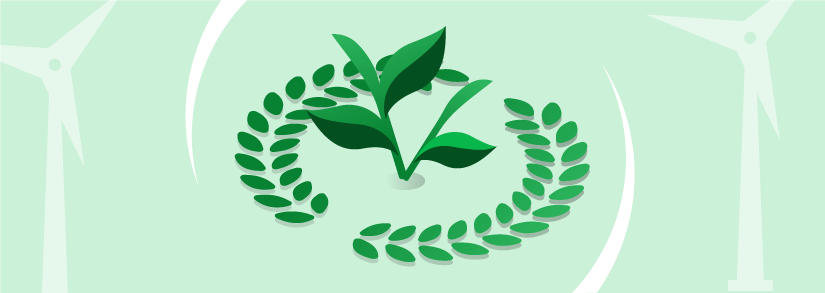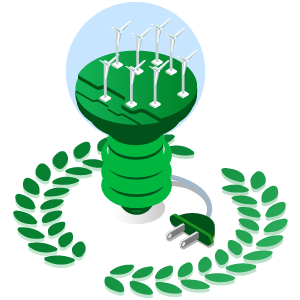Green Energy: advantages, examples, and suppliers

Green energy plays a key role in the energy transition due to its low environmental impact. It offers an alternative to non-renewable energy and helps fight global warming by not producing greenhouse gases or increasing carbon emissions. But what is green energy? What are its advantages? And how can you switch to it? Read on further to find out!
What is green energy?
"Green" energy is clean energy that, unlike fossil fuels, is non-polluting that comes from 100% renewable sources, meaning it does not harm the environment and is more sustainable. We tend to confuse clean energies with renewable energies. The key difference is that all renewable energies are clean, but not all clean energies are renewable.
What is the difference between renewable energy and clean energy?Renewable energy comes from resources provided by nature - the wind and sun being the most obvious examples. Clean energy is energy that produces little or no pollution. It includes renewables, but it also includes nuclear energy and the carbon-neutralising impact of technologies like carbon capture and sequestration (CCS).
For example, nuclear energy is clean because it is decarbonised and does not emit greenhouse gases into the atmosphere. However, this energy is not renewable because uranium, its fuel, is a limited resource.
What are the types of green energy?
There are several types of renewable energy from obtaining natural resources such as wind, water or the sun.
| Green Energy | Source | Technology | Use |
|---|---|---|---|
| Solar energy | Sun | Photovoltaic, thermosolar | Electricity, heating, cooling |
| Wind power | Wind | Wind turbines | Electricity |
| Hydroelectric energy | Water | Hydroelectric plants | Electricity |
| Geothermal energy | The Earth | Surface geothermal systems and heat pumps | Electricity, heating and cooling |
| Bioenergy | Biomass | Biomass combustion, biogas plants, biofuels | Electricity, heating and cooling, transportation |
- Solar energy is a renewable energy produced from sunlight, so it is also an intermittent energy. It takes advantage of solar energy in two ways: with photovoltaic technology and with thermal technology. Photovoltaic solar energy converts the sun's rays into electricity through the use of photovoltaic plates or panels, while solar thermal energy is generally used to heat fluids, such as domestic water heaters.
- Wind energy depends on the strength of the wind. It comes from turbines, called wind turbines or air turbines, which convert the kinetic energy of the wind into energy.
- Hydraulic or hydroelectric energy transforms the kinetic energy of water into electricity through hydroelectric plants. Like wind or solar power, hydropower is intermittent: it depends on the flow of water (dams, rivers, streams, etc.) and on rainfall. In other words, the drier the year, the less hydroelectric energy will be produced and vice versa.
- Geothermal energy is a process that takes advantage of the Earth’s natural heat and converts it into energy. It is one of the only renewable energies that is not intermittent and therefore does not depend on atmospheric conditions.
- Biomass is used to produce electricity and fuel (for example, biogas) from the heat released by the combustion of organic plants or animal waste, or from their fermentation. The energy from plant waste has the advantage of being carbon neutral. In fact, burning plant waste produces as many CO2 emissions as it absorbs during photosynthesis. It is important to know that biomass is only considered a renewable energy source when its consumption is less than its regeneration. Its two main production techniques are as follows:
- Biomass by combustion to produce electricity: during its combustion, organic waste (wood, agricultural waste, household waste) produces heat and electricity.
- Biomass by methanation to produce biogas: during its fermentation, organic waste (domestic, agricultural, agro-industrial) is transformed into biogas.
Renewable energy generated by wind, sunlight, water and wood made up 42% of the UK’s electricity in 2020, according to climate think tank Ember. Although renewable energy overtook fossil fuels in the final months of 2019, last year was the first time that renewables were the main source of the UK’s electricity over a 12-month period.
Advantages of green energy

Green energy has many advantages including:
- Clean energy;
- Inexhaustible energy source;
- No carbon emissions or greenhouse gases;
- Energy independence;
- Self-sufficient;
- Sustainability;
- Environmentally-friendly and slows down climate change.
In addition to contributing to the protection of the environment, using green electricity and green gas can also help you make savings on your bills.
How to contract green energy suppliers?
There are many ways to have green electricity at home. Among you options of green energy suppliers in the UK are:
- Large companies that, despite continuing to generate non-renewable energy, offer their customers green energy rates.
- Small companies specialised in renewable energies;
- Renewable energy cooperatives (the user must become a member by paying a monthly fee).
If the client has a non-renewable energy contract and wishes to switch to a 100% green energy rate, they simply need to contact the company that offers this rate and switch tariffs.
- Typical information you’ll be asked for to switch energy supplier
- Full name
- Address
- Meter reading
- Tariff you are interested in
- Bank information to set up direct debit
How long does it take to switch energy suppliers?
When you switch energy suppliers, it can take up to three weeks for the process to be complete - which includes a two-week ‘cooling off’ period - giving time to really decide if you want to change. If it’s been more than 15 working days and you haven’t been switched, contact the supplier to check they have the information they need.
Is green electricity more expensive?
The price of green energy is not higher than the other rates. However, the client must contract the one that offers the best conditions and electricity prices depending on their estimated consumption.
To do this, they should compare the different green electricity offers on the market. With the help of Selectra, the customer will be able to find the cheapest green rate that best suits their needs and consumption habits.
Who are the best green energy suppliers in the UK?

Carbon footprint offsetting with Climate Consulting
Schedule a call with our consultants to find out how you can reduce your company's emissions.
At present, there are numerous electricity suppliers that sell green energy to their customers in order to promote and extend efficient consumption from renewable sources.
Here is a list of the best green energy suppliers in the UK:
| Company | Description |
|---|---|

|
|

|
|

|
|

|
|
Green energy in the UK
The UK has been at the forefront of helping drive the change to net zero carbon emissions. At the end of 2020, Prime Minister Boris Johnson revealed ambitious plans for the nation to be net zero by 2050. In order to achieve that figure, as well as funding numerous projects such as building windfarms and investing in more solar energy options, the government has introduced various schemes to encourage others to take action. These include:
- The Renewable Obligation (RO): intended to encourage renewable electricity generation for large scale installations. It requires suppliers to source an ever increasing amount of the electricity from renewable sources. The RO rewards renewable output over the lifetime of a project.
- The Feed-in Tariff (FiT): designed to support small scale renewable installations up to 5MW. Through FiTs, generators are paid a tariff for every unit of electricity they produce. Any electricity not used on site can also be sold back into the national grid, and generators are paid extra to do this.
- A new scheme to support renewables and other low carbon technologies is currently being developed through Electricity Market Reform.
Discover more of our guides on environmental protection and sustainable development!
